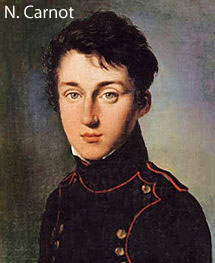As far back as 1676 Gottfried Leibniz attempted to describe and explain what got transferred between two snooker balls when a moving ball rolled into a stationary ball causing it to move.
He said that a "living force" got transferred from one ball to the other in the collision.

We can see what he was getting at, I think.
But it was not until a further 126 years had passed, in 1806, that Thomas Young first used the word "energy" to describe what got passed on in such physical situations.

Unfortunately, Thomas Young was not one for pushing himself or his ideas forward and so his use of the word "energy" was not fully adopted until another 50 years had passed, when in the 1850's a variety of physicists began to use terms such as kinetic energy and potential energy.
But we are moving too quickly!
What happened in the 126 years between Leibniz's "living force" idea and Thomas Young's concept of "energy"?
The answer is - the Steam Engine had been invented and had radically changed society, particularly in Britain.
In the 100 years of the 18th century, 1700 to 1799, the steam engine was progressively developed and employed in factories, mines and rail transport systems; it heralded the Industrial Revolution.
But remarkably, during those 100 years, nobody understood the fundamental nature of the steam engine and nobody realised that understanding it would lead to the beginning of understanding everything that goes on in the universe!
At the start of the 19th century, a time when Napoleon, in France, was trying to dominate Europe, Nicolas Carnot, a very young Physicist was determined to uncover the fundamental nature of the steam engine because he wanted France to beat Britain and he knew that Britain's power lay in its use of steam technology.

He was convinced that the current, vague description of the steam engine as a means of moving the "living force" around, was hopelessly inadequate.
In 1814 having analysed the steam engine he hit upon a fundamental (and simple) understanding of what was really going on within all types of steam engine.
He realised that energy flowed in the system from a hot source (an energy store) to a cooler source (another energy store) and it flowed like water falling from a height.
Furthermore, like water falling from a height, the flow of this substance (energy) could be tapped by diverting it towards another energy store, to do useful work.
In the real steam engine, the energy of the spinning wheel would be used, for example, to raise coal from mines or to pump water where it was needed or to drive a train.
Carnot also realised that to make this "Heat Engine" more efficient all you had to do was increase the temperature difference between the hot store and the cooler store.
This is why, today, car engines are more efficient than steam engines because they run at a higher temperature; jet engines are even more efficient because they run extremely hot and rocket engines are still more efficient.
Carnot had finally understood how energy moved within the steam engine and with it he had achieved more than he had intended; he not only understood the steam engine, but he had gained an understanding of the fundamental nature of energy:
that energy flowed within systems,
from one store to another store
and that it could be made to flow to other stores to do useful work.
And perhaps most importantly of all, that energy was just one "thing". It sat in many different stores and it flowed on many different paths but it was all just "energy".
Carnot died at the early age of 36 but his work was developed by eminent scientists such as Rudolf Clausius and Lord Kelvin to form a branch of Physics known as Theromodynamics.
His description of a "Heat Engine" is still studied in universities today and it is the first Energy System that we will consider in the next section.